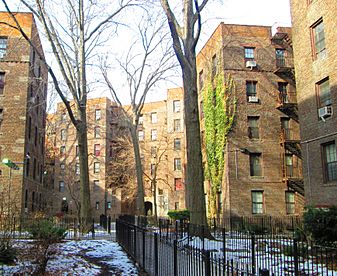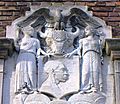Dunbar Apartments facts for kids
|
Dunbar Apartments
|
|

courtyard (2014)
|
|
| Location | W. 149th and 150th St btwn Frederick Douglass & AC Powell Jr. Blvds. Manhattan, New York City |
|---|---|
| Area | 4.2 acres (1.7 ha) |
| Built | 1926–28 |
| Architect | Andrew J. Thomas |
| Website | https://dunbarapts.com/ |
| NRHP reference No. | 79001601 |
Quick facts for kids Significant dates |
|
| Added to NRHP | March 29, 1979 |
The Dunbar Apartments, also known as the Paul Laurence Dunbar Garden Apartments, is a group of buildings in Harlem, Manhattan, New York City. They are located on West 149th and West 150th Streets.
These apartments were built between 1926 and 1928. John D. Rockefeller, Jr. had them built to offer good homes for African Americans. It was the first large housing project of its kind for this community. The buildings were designed by architect Andrew J. Thomas. They were named after Paul Laurence Dunbar, a famous African American poet.
The complex has six separate buildings. Together, they originally had 511 apartments. They take up a whole city block. The buildings are built around a central garden courtyard. Each building is shaped like a "U". This design helps every apartment get plenty of fresh air and sunlight. The Dunbar Apartments are known as the first large "garden-complex" in Manhattan.
The complex became a New York City Landmark in 1970. It was also added to the National Register of Historic Places in 1979.
Contents
A Special Housing Idea
The Dunbar Apartments were built as a new way to solve housing problems. At the time, there was a shortage of homes in Harlem. This project aimed to provide good housing for African Americans.
How the Cooperative Worked
Instead of renting, the apartments were part of a housing cooperative. This meant tenants could eventually own their homes. They paid a down payment of $50 for each room. Then, they paid $14.50 per room each month. Most of this money went towards paying off a loan on the apartment. If all payments were made on time, tenants would own their apartment in 22 years. This was the first big cooperative housing project for African Americans. It was also New York City's first large garden apartment complex.
Life at the Dunbar Apartments
The first people who lived here were mostly middle-class families. The complex even offered affordable childcare on-site. This helped mothers who worked.
Challenges and Changes
The Dunbar Apartments opened in 1928. Just one year later, the Great Depression began. This was a very difficult time for many people. It became hard for tenants to make their payments. The building management had to change some rules. For example, people were allowed to take in lodgers to help pay.
However, too many tenants still could not pay. The buildings could not make their loan payments to Rockefeller. He took back the property in 1936. A year later, the apartments were changed to regular rental units.
In 2013, the Dunbar Apartments were sold to a new developer. There are plans to make upgrades and improve the buildings. This includes fixing up empty apartments and making the courtyard better. They also plan to add new features like a fitness center and a playground.
Images for kids



